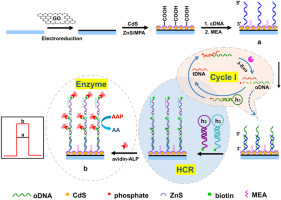Biosensors and Bioelectronics ( IF 12.6 ) Pub Date : 2018-03-13 , DOI: 10.1016/j.bios.2018.03.023 Xiao-Mei Shi , Gao-Chao Fan , Xueying Tang , Qingming Shen , Jun-Jie Zhu

|
Sensitive and specific detection of DNA is of great significance for clinical diagnosis. In this paper, an effective cascade signal amplification strategy was introduced into photoelectrochemical (PEC) biosensor for ultrasensitive detection of human T-cell lymphotropic virus type I (HTLV-I) DNA. This proposed signal amplification strategy integrates λ-exonuclease (λ-Exo) aided target recycling with hybridization chain reaction (HCR) and enzyme catalysis. In the presence of target DNA (tDNA) of HTLV-I, the designed hairpin DNA (h1DNA) hybridized with tDNA, subsequently recognized and cleaved by λ-Exo to set free tDNA. With the λ-Exo aided tDNA recycling, an increasing number of DNA fragments (output DNA, oDNA) were released from the digestion of h1DNA. Then, triggered by the hybridization of oDNA with capture DNA (cDNA), numerous biotin-labeled hairpin DNAs (h2DNA and h3DNA) could be loaded onto the photoelectrode via the HCR. Finally, avidin-labeled alkaline phosphatase (avidin-ALP) could be introduced onto the electrode by specific interaction between biotin and avidin. The ALP could catalyze dephosphorylation of phospho-L-ascorbic acid trisodium salt (AAP) to generate an efficient electron donor of ascorbic acid (AA), and thereby greatly increasing the photocurrent signal. By utilizing the proposed cascade signal amplification strategy, the fabricated PEC biosensor exhibited an ultrasensitive and specific detection of HTLV-I DNA down to 11.3 aM, and it also offered an effective strategy to detect other DNAs at ultralow levels.
中文翻译:

用于检测HTLV-I DNA的超灵敏光电化学生物传感器:级联信号放大策略,将λ-核酸外切酶辅助的靶标回收与杂交链反应和酶催化相结合
DNA的敏感和特异性检测对于临床诊断具有重要意义。在本文中,一种有效的级联信号放大策略被引入到光电化学(PEC)生物传感器中,用于超灵敏地检测人T细胞I型淋巴病毒(HTLV-1)DNA。该提议的信号放大策略将λ-核酸外切酶(λ-Exo)辅助的靶标回收与杂交链反应(HCR)和酶催化相结合。在HTLV-1的靶DNA(tDNA)存在下,设计的发夹DNA(h 1 DNA)与tDNA杂交,随后被λ-Exo识别并切割,从而形成游离tDNA。借助λ-Exo辅助的tDNA回收,从h 1的消化中释放出越来越多的DNA片段(输出DNA,oDNA)脱氧核糖核酸。然后,通过oDNA与捕获DNA(cDNA)的杂交,许多生物素标记的发夹DNA(h 2 DNA和h 3DNA)可以通过HCR加载到光电极上。最后,可通过生物素与抗生物素蛋白之间的特异性相互作用将抗生物素蛋白标记的碱性磷酸酶(抗生物素蛋白-ALP)引入电极上。该ALP可以催化磷酸-L-抗坏血酸三钠盐(AAP)的去磷酸化,以产生抗坏血酸(AA)的有效电子给体,从而大大增加了光电流信号。通过利用提出的级联信号放大策略,所制造的PEC生物传感器对HTLV-1 DNA的超灵敏和特异检测可低至11.3 aM,并且还提供了一种有效的策略以超低水平检测其他DNA。



























 京公网安备 11010802027423号
京公网安备 11010802027423号